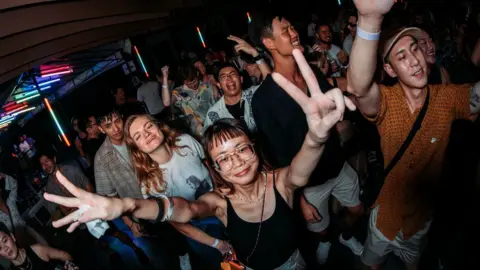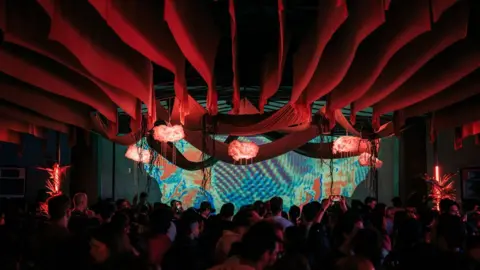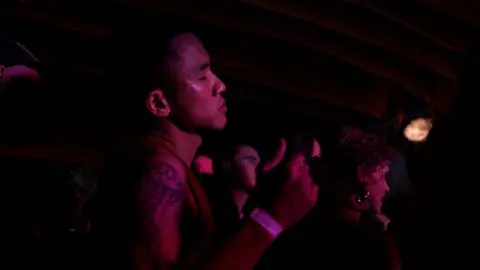Singapore's rave scene offers freedom in a strait-laced city
 VICKIE ZHANG
VICKIE ZHANGAloysius, a 23-year-old dancer, spends his day completing his mandatory military service in Singapore.
So at night on the weekends, "Loy" as he calls himself, goes raving. Under the lights and in the heat, he's shedding a skin, seeking release.
Last November we met at a rave at Haw Par Villa - a hell-themed amusement park in the city's west dotted with statues of figures from Chinese mythology: topless mermaids, warrior demons and wizened old sages like Confucius.
It was twilight, and Loy and his friends were jolting to a thumping bass drifting up from a space below.
Down in the "Culture Courtyard", crowds were shuffling to a grimy funk track which morphed into revved-up disco then deep house.
Behind the DJ, projections of swirls crawled over a loop of a Chinese palace drama. In front of the decks, a moving mass lifted drenched faces to the screen.
Plunging into that crowd was like stepping into a greenhouse. The heat that encased everyone on the dance floor - a sea of bum bags, bucket hats and sunglasses - was a reminder as to why most Singaporean residents stick to air-conditioning.
But the space was buzzing.
"Now everyone's revenge partying," said Loy. "The Covid policies here were just so insane."
 IMRAN HM
IMRAN HMFor two years, Singapore enforced a no parties, no nightclubs rule - and only reopened live music venues in April 2022.
Bars couldn't serve drinks past 22:30 and group hangouts were restricted to six people. "Red Shirt" officials patrolled streets looking for rule-breakers. Social distancing meant every second seat was taped off at a hawker centre or cinema.
Now the party scene has roared back to life - and the underground scene in particular has seen a boom. New collectives, niche groups borne out of lockdown, have emerged.
Next weekend, a dozen collectives will descend on the Golden Mile tower complex in central Singapore. It has been home over the years to mum-and-pop shops, karaoke lounges and seedy cinemas - and was most recently a hub for the city's Thai community.
But in common Singapore fashion, a developer sale means it's due for the wrecking ball later this year. In many ways a final party at the tower is the perfect setting for a rave in the city.
Singapore's sky-high rents and zoning laws mean finding a space is often the hardest issue, party promoters say.
So the settings are always temporary. Raves have been held in basements and arthouse cinemas. A regular techno event has a home in a Japanese izakaya on the river quays. One Afrobeat group played in a replica film set from Wong Kar-wai's film In The Mood for Love.
Crypto bros and migrant workers
The rave scene is a meeting place for Singapore's counter-culture. For many, it's even a rebellion against the city's commerce heart - a dark dancefloor the perfect counterpoint to skyscrapers and sterile malls.
Music journalist Kevin Ho has documented the city's music scene for years on his site Life in Arpeggio.
He says the image of Singapore is "of a rich country with lots of rules, and that the party culture would be all about the commercial world".
But Singapore's real self, as a "crossroads of Asia", comes out on the dancefloor, he argues.
It's there you see the melting pot of nationalities, ethnicities and classes - a diversity that ranges, as DJ Dean Chew put it, "from crypto bros to migrant workers".
At first it can seem like a "clash in culture", says Chew, a 15-year rave scene veteran with his Darker than Wax collective and now owner of music bar Offtrack.
But a dancefloor is a great unifier. "Everyone just starts partying with the music, getting loose. And you start seeing these great compositions."
It's that taste of freedom that draws many to the scene. At Haw Par Villa, I met two young women in the bathroom queue, who were still new to the scene. One had on a red Make Panda Mate Again cap while the other wore cargo pants and a crop top.
Both had returned to Singapore during the pandemic after university in Melbourne, Australia - which is where they first encountered rave culture.
 IMRAN HM
IMRAN HMThey used to go out to the mega clubs in Singapore, where vast multi-level spaces blast commercial dance music. Often these venues have floor cheerleaders, strobe-light champagne bottles and other laugh-out-loud gimmicks like a ferris wheel inside a club.
But the music is terrible and the alcohol expensive, they say. "It's more a status thing, like it's not really satisfying," one of the women, Eugenia, adds. She doesn't deign to dance at those clubs - she says those spots are more about being seen.
"But I come here because I actually want to enjoy the music. Like I actually want to dance!"
Where difference is embraced
Later that night I spotted Loy and his friends again in the crush. Bathed in red light, they were dancing with abandon, a sweaty sheen on their faces.
Earlier he'd told of how much more open and free the rave scene felt compared to other clubs in the city.
For one there's the cost. Raves are typically a third of the price of clubs in Singapore which can charge up to SGD$60 (£37; $45) at the door.
"With the clubs and the beach clubs, there's still like this capitalism thing where if you spend more money you can get a better spot. Like at a club, if you pay more you can get on to a higher level," Loy said.
"But at a rave everybody's on a level playing field. That's my favourite part of it - everyone's really just there to dance."
Rave culture also celebrates an individuality often restricted elsewhere in Singapore's conservative society.
Loy, who is gay, says the underground scene still offers that safe space.
"Definitely in recent years we're opening up more, the queer scene's getting more active and everything is happening," he says.
"But you will still feel barriers - I mean it's Singapore and it's conservative. I feel it will be conservative as long as I'm alive."
 VICKIE ZHANG
VICKIE ZHANGIn Singapore, same-sex couples might feel free to walk down a street holding hands but the city still bars same-sex marriage, and censors media from depicting gay relationships.
Gay couples and singles are also denied access to the housing market for years longer than their married peers. And while the country last year repealed a law that criminalised sex between men, it also reinforced its definition of marriage - and the government benefits that come with it - as between a man and woman.
"Even the word 'rave' has conflicting notions with a place like Singapore," says Ho.
"I think when most people think of raves they think of illegal, drug-soaked events in a warehouse or dark location."
But there is little lawlessness in Singapore, where surveillance cameras dot street corners and warnings about etiquette fines are plastered on public transport.
The city-state strictly prohibits recreational drugs and carries out the death penalty for drug trafficking - a policy supported by the majority. Last year it executed a man who trafficked a tablespoon of heroin from Malaysia, despite pleas for clemency because he was intellectually impaired.
"What you would find in a rave anywhere else across the world, you won't find in Singapore because of our extreme, excessive stance on drugs," says Kevin.
The city's rave scene is still fleshing itself out. Non-licenced raves don't really exist - any dancefloor needs the government's permission, and promoters say there's a mountain of red tape.
For the Haw Par Villa rave, organisers had to get applications approved by more than a dozen government departments.
"It's really difficult to operate here. It's one of the probably toughest places to get stuff done creatively," says DJ Chew.
"But if you can, something beautiful and powerful comes out of it, like a flower pushing up from a crack in the concrete."
